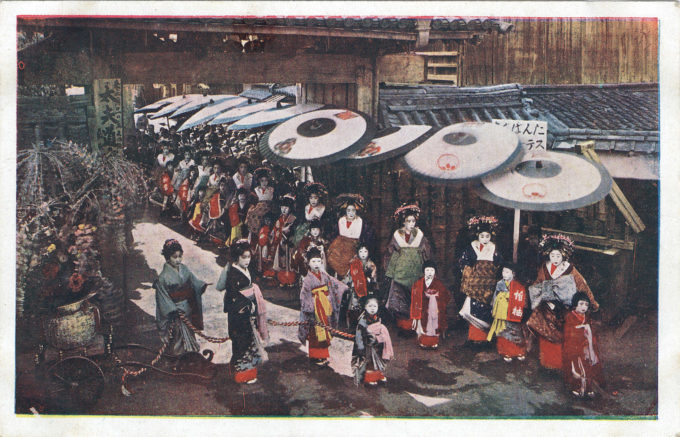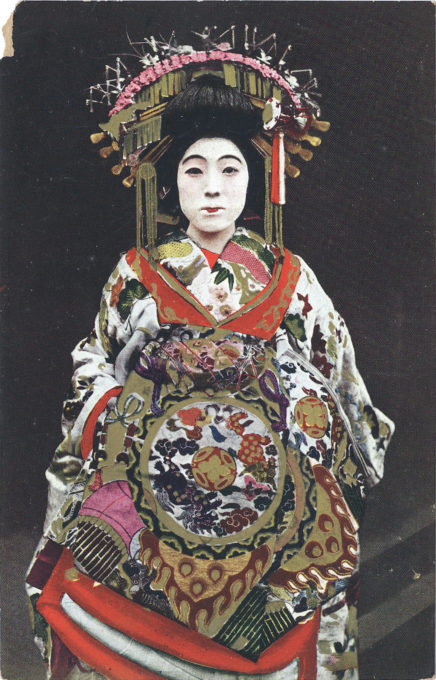“It is the day of the Tayū dochu [‘tayū walking through’].
“Now the houses are decorated with showy lanterns, and from above the lintel of each doorpost flames a scarlet lobster. Once each year during this pink glory of cherry-blossoms the Priestesses of Pleasure move in procession through the city.
“From out the Houses of Myriad Flowers come Evening Mist and Filmy Cloud, to be closely followed by Face of Evening, A Thousand Springs, Fragrance of Plum Blossom, and a hundred others.
“They are accompanied by an army of attendants, some to push the crowd aside; others, carrying a great lantern emblazoned with her crest, precede each courtesan; still others walk a step behind the gorgeous ones, to cover them with long-handled paper umbrellas; while two girl pages, one on each side, respectfully guide the tiny footsteps as would acolytes in some priestly procession.
“These courtesans are like painted idols. Their faces are as white as snow, their eyelashes black, their lips vermilion, and their toe-nails stained pink. In gorgeous, sweeping robes, and with hair haloed by radiating pins of coral and tortoise shell, they solemnly totter along on high clogs of black lacquer, a step a minute. One foot is put out a fraction of an inch and planted firmly; then the other is swung round in front of the first and across it, as a skater doing a figure eight.
“Looking neither to the right nor to the left, followed by a dense but silent crowd, they stumble through the narrow streets from their home to the ‘guide house’ and back, on a supposed errand of thanks for favors received.”
– Japan in Silhouette, by Trowbridge Hall, 1925

“Kyoto Tayū dochu”. Procession of tayū and kamuro (child attendants) through the “flower town” (hanamichi) licensed quarter, Kyoto, c. 1920. Tayū were the premiere courtesans, learning the arts of the nobility while geisha learned the arts of the common people. During this famous annual late-April parade, tayū wore their finest kimono, and walked on 8-inch high three-toothed black lacquered wooden geta (koma geta) accompanied by their young attendant apprentices.
See also:
“Gion Kobu Hanamikouji”, Kyoto, c. 1920.
Gion Matsuri (Gion Festival), Kyoto, c. 1930.
Kamuro (attendant) at Yoshiwara, c. 1910.
“In the early days of the Shimabara [Kyoto] quarter, there were seven celebrated tayū courtesans in Kyoto. Of these, Yoshino was the most adored. Many legends have gathered around her, not least that she was the lover of Miyamoto Musashi, the greatest swordsman of all time and author of The Book of Five Rings (the bible for katana practitioners of the martial arts, and more recently for businessmen). He learned his secrets, so the story goes, from the gentle but insightful Yoshino.
“Yoshino was entertaining him and his friends in the pleasure quarter one snowy night when he slipped quietly out of the room. She was the only one to notice him leave. He returned a few minutes later. But there was a splash of red on the hem of his kimono.
“‘What is that?’ asked one of his friends.
“‘Just a peony petal,’ said Yoshino and quickly wiped it away with a napkin.
“When the party came to an end, she suggested lightly that he had better stay there with her. With her unerring instinct she had guessed that he had been engaged in a duel to the death in the few minutes he had been away. The retainers of the two men whom he had killed, several dozen of them, were waiting right outside to ambush him and exact revenge.
“Sitting in her chamber he was silent, tense in anticipation of the hopeless battle that lay ahead. Suddenly Yoshino picked up her biwa, a priceless lute, took a knife, and smashed the curved sound box to pieces. From the ruined instrument she picked out the crosspiece, a single piece of wood, and showed it to him.
“‘This,’ she explained, was the heart of the instrument; all the sound came from this. If the crosspiece were as taut and unyielding as he was at that moment, a single stroke of the plectrum would break it. But if he could be as flexible and responsive as it was, no one could defeat him.
“Inspired by her words, he bounded out into the snow and, with a few nonchalant slashes of his sword, decimated the dozens of men gathered outside. For the rest of his sword-wielding career, he never forgot her or her advice.”
– Women of the Pleasure Quarters: The Secret History of the Geisha, by Lesley Downer, 2001.


